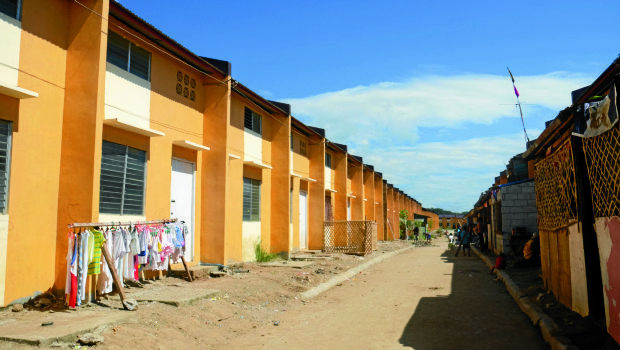Little comfort for settlers in farmlands converted into relocation sites

Settlers in Pandi Heights in Pandi, Bulacan, contend with lack of water and electricity, and limited livelihood and job opportunities in the former farming area. —MATTHEW REYSIO-CRUZ
Liza Ricablanca, 24, has lived in a house at St. Martha’s Estate Homes in Barangay Batia in Bocaue, Bulacan province, since 2014. Her family, alongside 500 other informal settler families, had been relocated from her old house on Road 10, Tondo, Manila, after the Department of Public Works and Highways demolished shanties there to make way for a P100-million road-widening project.
But nearly three years after, prospects of a better life in their new home still remain dim. Like other new relocatees, Ricablanca suffers from poverty due to limited economic opportunities in the area and the extremely high cost of living.
Their situation shows the lack of effective urban planning for the housing sector and resettlement sites. Settlers are often moved to sites where few jobs are available and have no access to basic services.
Bulacan is home to thousands of informal settlers from Metro Manila. Its proximity to the capital and its vast agricultural lands have made the province a popular choice for government resettlement sites, such as St. Martha’s in Bocaue and Pandi Heights in Pandi.
An inspection of these sites showed the glaring lack of basic amenities.
Article continues after this advertisementIn St. Martha’s, Ricablanca said, water was not only scarce but also hardly potable. Her son, then 3 months old, died from severe diarrhea before they could even reach the hospital, which was an hour’s ride away.
Article continues after this advertisementPeople were relocated to Pandi Heights even before a water system was completed. Only one pump serves every 10 or so houses, and it is turned off at 6 p.m.
Most of the settlers look for jobs in Metro Manila despite the high transport fares. “If you’re not resourceful, you’re not going to survive here,” Ricablanca noted.
The problems plaguing resettlement sites highlight the challenges facing the housing sector and the Housing and Urban Development Coordinating Council (HUDCC).
In 2016, the HUDCC reported a massive housing backlog of 5.6 million units, a phenomenon further exacerbated by competing uses of land and limited appropriations for housing.
HUDCC Director Paolo Salvosa said his office was aiming to strengthen land management in the context of urban planning, including the construction of housing units with access to livelihood and basic amenities.
“[These resettlement] places should be close to their livelihood, otherwise, the site shouldn’t be considered at all,” Salvosa said. —MATTHEW REYSIO-CRUZ, JINKY CABILDO AND KRIXIA SUBINGSUBING